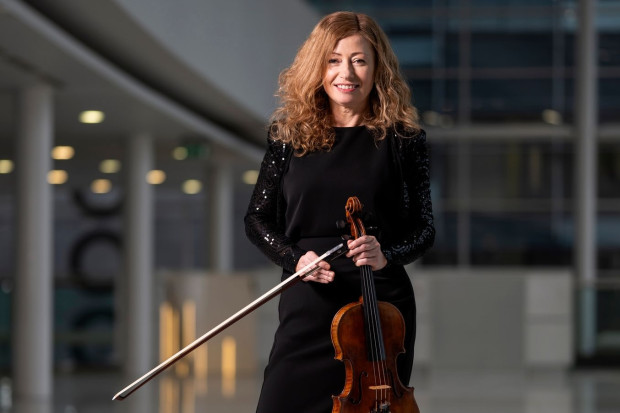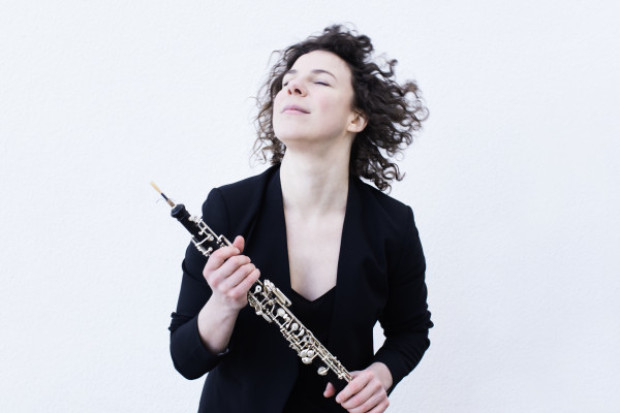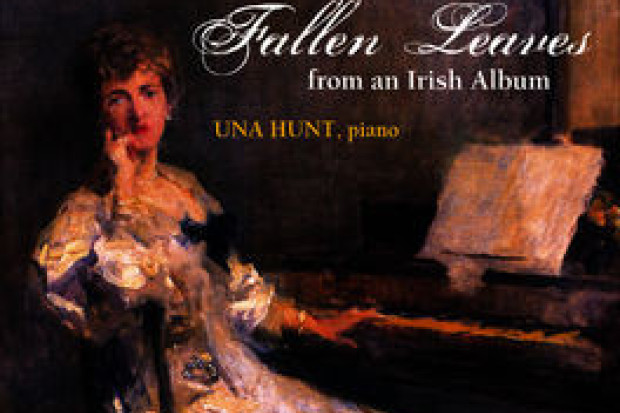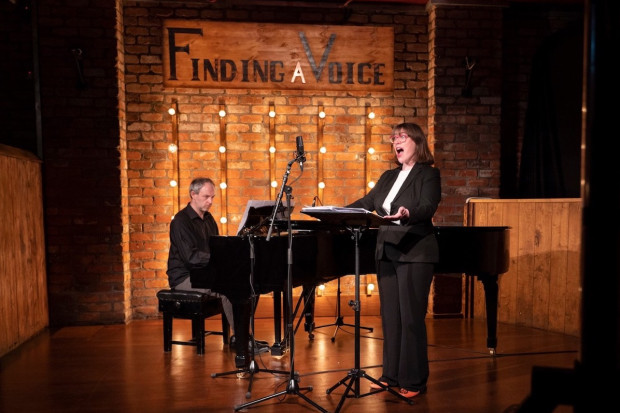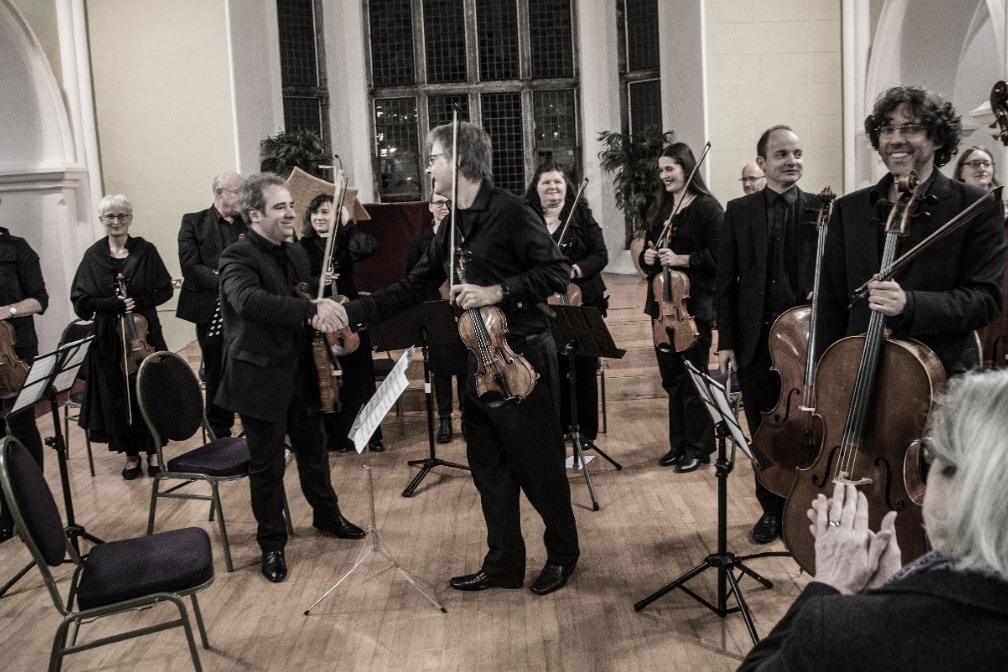
Members of Luminosa at the launch in November.
Shining a New Light
Launched last November, Galway’s new orchestra Luminosa held its first two concerts in April and June of this year. The group is the initiative of Lucy Hayward and it draws on the musical strengths of the west: the four members of ConTempo Quartet are all section principals, and Paul Ezergailis, who is co-principal of the Oslo Philharmonic Orchestra, is Concertmaster. The ranks of each section are filled by musicians who perform with national and international orchestras but are based in or near Galway.
The programme for the first concert at Galway Cathedral (15 April) consisted of all female composers, from Hildegard von Bingen, Joan Trimble and Jane O’Leary to Fanny Mendelssohn, Marian Ingoldsby and Elizabeth Maconchy. From the beginning, the format was different too, with Ezergailis playing von Bingen’s ‘O Virtus Sapientiae’ solo behind the audience before the orchestra joined in with drones and chordal accompaniment.
The concert mixed music from four different centuries. Trimble’s Suite for Strings with its mix of Irishness and modernism showcased the seventeen-piece orchestra but in particular the strength of its first desk, with Ezergailis and ConTempo first violinist Bogdan Sofei forming a partnership that always drew your attention.
O’Leary’s Snapshots was written post 9/11 and before the invasion of Iraq in 2003, when there was ‘an ominous atmosphere in the world’. If you are familiar with the sparse and delicate textures of O’Leary’s music, this work will surprise you with its thicker textures and rippling sections. The combination of music and poetry, with Grace Kiely reading, was particularly poignant. Like the O’Leary, Ingoldsby’s Winter Sun was dark in theme, but a much more gentle, meditative piece. With soft pizzicato and slowly resolving harmony, it gradually brooded more towards the end.
Maconchy’s Music for Strings and Mendelssohn’s Quartet in E-flat were interesting to hear, and while the former displayed the skill of the orchestra, the latter’s direct, emotional writing stood out more. Luminosa concluded with von Bingen again, giving the whole evening a clear sense of unity. In this debut concert, with such a confident, curated approach, it was surprising just how quickly Luminosa was establishing a strong identity for itself.
Venues
However, the concert also hinted at the limitations of musical life in the west, in the sense that Galway Cathedral is not a suitable venue for orchestral music. There is in fact no professional concert venue in the city with the necessary acoustic and facilities. Every local and visiting promoter has to make do, and too many notes have been lost in the echo of St Nicholas’ Collegiate Church in particular. While the Cathedral acoustic may have worked for the O’Leary and von Bingen, details vanished in the Trimble and Maconchy. The difficulties with the venue became even clearer in Luminosa’s second concert on 16 June.
This second outing took the theme of ‘Landscape and Music’ with works by Arthur Duff, John Maxwell Geddes, Elgar, Grieg, Barber and Bill Whelan.
Duff’s Meath Pastoral from 1940 is a pleasant short work for strings, conjuring up images of the countryside, though not necessarily of anywhere in particular. Scottish composer Geddes’ three-movement Soundposts is also an appealing divertisement for strings, with musical elements of Scottishness. Despite Luminosa’s intense performances, however, neither work had the invention to give the concert an impactful opening. It was left to Elgar’s Serenade for Strings – the slow movement in particular – and Grieg’s Two Elegiac Melodies to give the early part of the concert more musical weight.
In the second half, what should have been a highlight, and a chance to show off what Luminosa can do, Barber’s famous Adagio for Strings, unfortunately did not transpire successfully. From the beginning, the pace was more brisk than one might expect, which meant one couldn’t enjoy those long, tragic changing harmonies. There was also a breakdown in communication between violins and cellos at one stage which meant an entry was missed and any emerging intensity was lost.
The final piece was Whelan’s three-movement Inishlacken scored for classical violinist, traditional Irish fiddler and orchestra, featuring Sofei and Lynda O’Connor as soloists. The opening movement ‘The Currach’ began with fabulously forceful playing from Sofei, but again, because of a noticeably quick tempo, once O’Connor joined in we began to miss the details in the Cathedral’s acoustic. In any case, the work needs a slightly more relaxed tempo in order to allow the fiddle bring in traditional Irish music’s characteristic swing. Without that, the melodies becomes more regimented and the core concept of the piece, a conversation between two traditions, is missing. This was most evident in the third movement ‘Evening Céilí’ in which both violins interweave even more closely.
Despite these difficulties, Luminosa received an ovation from the Galway audience. And a venture like this does need to be warmly applauded. A professional orchestra for the west can open up so many other creative avenues: opportunities for musicians and students, a chance for composers to hear their work, new repertoire being introduced to local ears, and thus general audience development for orchestral music.
But it is also through such initiatives that we can see the limitations of the musical infrastructure that we have in Galway, and perhaps Luminosa will further focus local and national authorities on the matter.
The group arrives at an exciting time for Galway, with the recent launch of the university’s first music degree, the European Capital of Culture celebration, and many other initiatives. Having a professional orchestra could act as a catalyst for so much more. In just two concerts, the group has presented a range of interesting work to full houses and it has shown what is possible with ambition, energy and collaboration. No matter what way you look at it, Luminosa is an exciting prospect.
Visit https://www.luminosa.ie/
Published on 12 July 2019
Toner Quinn is Editor of the Journal of Music. His new book, What Ireland Can Teach the World About Music, is available here. Toner will be giving a lecture exploring some of the ideas in the book on Saturday 11 May 2024 at 3pm at Farmleigh House in Dublin. For booking, visit https://bit.ly/3x2yCL8.




